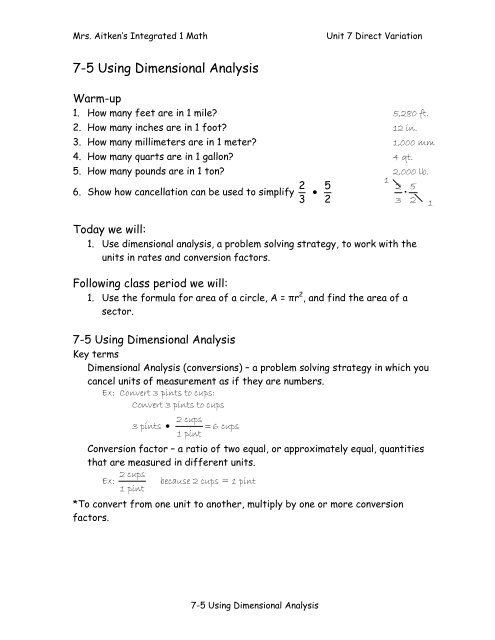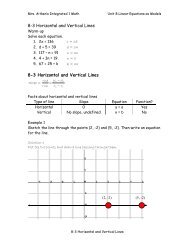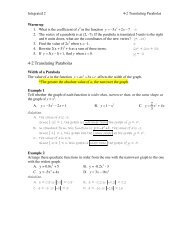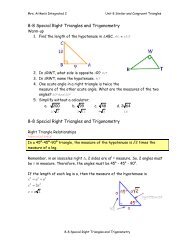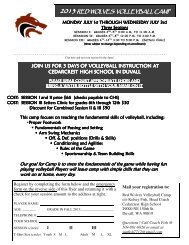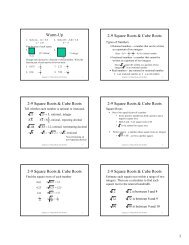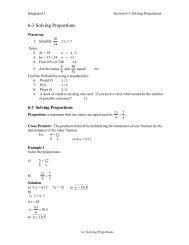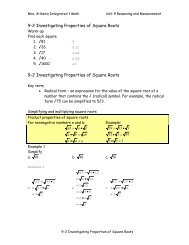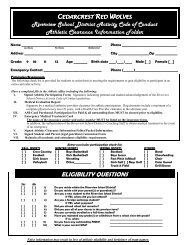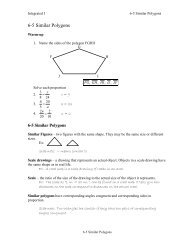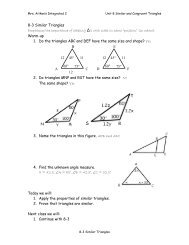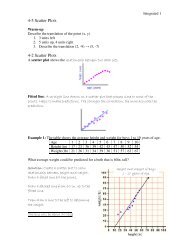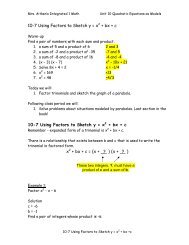7-5 Using Dimensional Analysis notes
7-5 Using Dimensional Analysis notes
7-5 Using Dimensional Analysis notes
You also want an ePaper? Increase the reach of your titles
YUMPU automatically turns print PDFs into web optimized ePapers that Google loves.
Mrs. Aitken’s Integrated 1 MathUnit 7 Direct Variation7-5 <strong>Using</strong> <strong>Dimensional</strong> <strong>Analysis</strong>Warm-up1. How many feet are in 1 mile? 5,280 ft.2. How many inches are in 1 foot? 12 in.3. How many millimeters are in 1 meter? 1,000 mm4. How many quarts are in 1 gallon? 4 qt.5. How many pounds are in 1 ton? 2,000 lb.2 56. Show how cancellation can be used to simplify •3 22 5 •3 2Today we will:1. Use dimensional analysis, a problem solving strategy, to work with theunits in rates and conversion factors.Following class period we will:1. Use the formula for area of a circle, A = πr 2 , and find the area of asector.7-5 <strong>Using</strong> <strong>Dimensional</strong> <strong>Analysis</strong>Key terms<strong>Dimensional</strong> <strong>Analysis</strong> (conversions) – a problem solving strategy in which youcancel units of measurement as if they are numbers.Ex: Convert 3 pints to cups:Convert 3 pints to cups2 cups3 pints • = 6 cups1 pintConversion factor – a ratio of two equal, or approximately equal, quantitiesthat are measured in different units.Ex: 2 cups because 2 cups = 1 pint1 pint*To convert from one unit to another, multiply by one or more conversionfactors.117-5 <strong>Using</strong> <strong>Dimensional</strong> <strong>Analysis</strong>
Mrs. Aitken’s Integrated 1 MathUnit 7 Direct VariationExample 4:The cost of gas varies directly with the amount bought. Sally paid $9.52 for 7gallons of gas.a) Identify the control and dependent variables.b) Express the variation constant as a rate.Solutiona) independent (x) : Amount boughtdependent (y): costb)k =yx$9.52 $1.36= → so $1.36/gallon7 gal gallonAdditional ExampleExample:To estimate the distance around your schoolyard, you pace around theperimeter and count 423 paces. You then measure the length of your stride andfind that 9 paces cover 25 feet. Assuming all of your paces are about the samelength, what is the distance in feet around the schoolyard?SolutionThe distance around the school yard is 423 paces. We need to convert this to feet.?423 paces = _____ feet? =The conversion factor goesSince we want to eliminate “paces” and be left with “feet”, the conversion factor shouldhave “paces” on the bottom, denominator, and “feet”, on the top, numerator. Since 9 of25 feetyour paces cover 25 feet, the correct conversion factor is9 paces .25 feet ⎛ 25 ⎞423 paces • = ⎜432 • ⎟ feet = 1175 feet9 paces ⎝ 9 ⎠HomeworkRead pg. 392-396Practice 56 and Conversion WSIn class problems (May be on a HW Summary)Pg. 396 #6, 8, and 107-5 <strong>Using</strong> <strong>Dimensional</strong> <strong>Analysis</strong>


